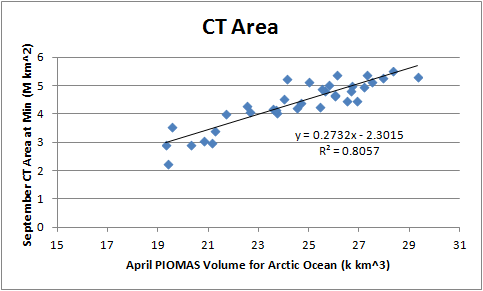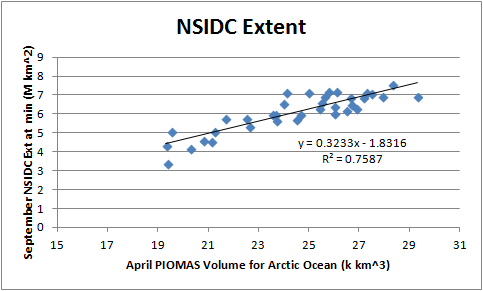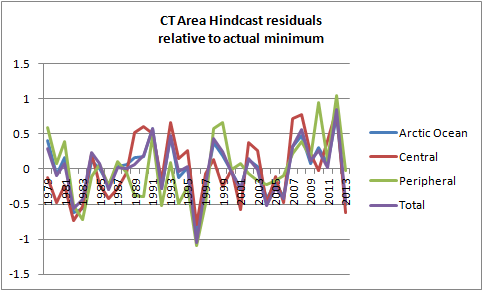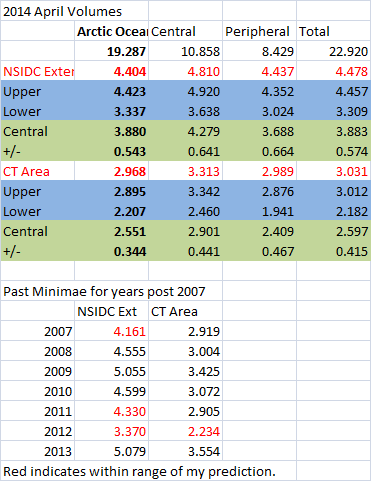Working on the assumption that volume decline is driving the decline in area (or extent) via increases in open water formation efficiency....
The relationship between April volume and September minimum extent/area is significant.


For the above two scatter plots I have calculated April monthly average PIOMAS volume for the Arctic Ocean (including CAA). This has been related to September daily minimum for the two indices stated. The assumption being that April volume within the Arctic Ocean is a significant factor in determining extent/area at minimum.
The R2 when using Arctic Ocean volume is maginally better than that for the whole PIOMAS domain (0.7455) and significantly better than either the peripheral seas of the Arctic Ocean (Arctic Ocean minus Central Arctic) (0.6529) or the Central Arctic region (0.6603) - R2s given for NSIDC Extent only.
Four equations are derived from similar scatter plots, regions being Arctic Ocean, Central Arctic, Peripheral, and Whole PIOMAS Domain. These are applied to the April volumes for each of the four regions for each year for which past data is available 1979 to 2013. While the predictions made depend on their respective April volume region, the predictions are for area/extent in the whole Arctic as covered by NSIDC Extent and CT Area. The residuals of these hindcasts are calculated for each region, these are graphed below for the NSIDC Extent hindcasts and the CT Area hindcasts.


Note that a positive residual represents an overshoot where the prediction exceeds the actual extent/area for the stated year.
It is clear that since 2007 the method consistently overshoots, so a largely one sided set of upper and lower bounds is applied to the prediction for 2014. The upper and lower bounds being simply the greatest positive and negative residuals in the period 2007 to 2012. 2013 is rejected as a weather driven outlier not anticipated to repeat in 2014.
The following table details predictions using the four datasets, the four sets are included for completeness, only the Arctic Ocean prediction is considered worth pursuing at present.

At the top of the table are listed April 2014 volumes from PIOMAS gridded data. In red are the NSIDC Extent and CT Area predictions for each April volume region, however as stated above the predictions apply to the whole Arctic for September daily minimum.
In blue shaded area are shown the upper and lower bounds of the predictions. In green shaded area the prediction is given in terms of a central and +/- symmetrical bounds.
Below the main table is listed the actual minimae in terms of CT Area and NSIDC Extent, figures highlighted in red are within the bounds for the prediction based on Arctic Ocean volume for 2014.
I am not yet making a formal prediction, had I been doing so I would be posting this at my blog (no offense but it would be the right place to do it). However, what can be considered my initial prediction based on April data is as follows:
NSIDC Extent September daily minimum between 4.4M and 3.3M km^2, with the likelihood towards the higher end.
CT Area September daily minimum between 2.9M and 2.2M km^2, with the likelihood towards the higher end.
Next task is to examine the residuals in terms of SLP, Greenland Blocking Index, what else? The aim being to see if the prediction can reasonably be tightened.
